The internet’s transformation has always followed human connection. What began as likes and shares has evolved into full-fledged marketplaces where personalities, not corporations, hold the buying power. Today, creators are not just entertainers or influencers; they are entrepreneurs commanding their own brands and driving billions in sales. This movement is what experts now call the Creator Commerce Revolution.
Unlike traditional eCommerce, where brands used ads to attract attention, creator commerce flips the equation—attention itself becomes the brand. Consumers increasingly prefer recommendations from trusted creators to polished advertising campaigns. They follow creators whose stories resonate, whose lifestyles inspire, and whose authenticity translates directly into purchasing behavior.
What Exactly Is Creator Commerce?
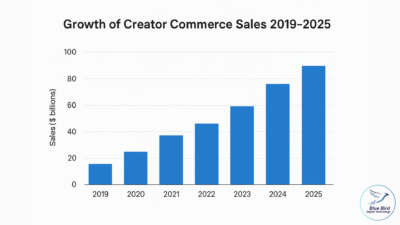
Growth of creator commerce sales 2019–2025 projection chart
Creator commerce is the integration of content creation and commerce. It means that a creator’s digital presence—on YouTube, Instagram, TikTok, or any platform—functions as both a storytelling channel and a direct sales engine. Followers don’t leave the social ecosystem; they discover, evaluate, and buy within the same scroll.
In practical terms, creator commerce represents:
-
Shoppable posts and videos embedded directly in feeds.
-
Affiliate links and brand collaborations generating revenue.
-
Creator-owned product lines, from digital templates to clothing brands.
-
Subscription communities offering exclusive experiences.
The result is a system where creators hold both cultural and commercial influence. They convert engagement into earnings, community into customers, and creativity into capital.
Why Traditional eCommerce Needed Creators

Creator Reviewing Product for Followers
The average online shopper is overwhelmed. There are millions of stores, identical products, and never-ending ads. Amid this digital noise, the most valuable currency has become trust. And trust, in the social era, resides not in logos but in people.
Creators bridge that gap. They humanize products, tell authentic stories, and maintain consistent communication with audiences who already believe in them. For brands, partnering with creators brings instant credibility. For consumers, it replaces skepticism with confidence.
This shift mirrors the evolution of advertising itself—from interruption to integration. In creator commerce, marketing doesn’t feel like marketing; it feels like advice from a friend.
The Economics of Trust
Trust has measurable economic value. Studies show that 70 % of consumers are more likely to purchase when a product is recommended by a creator they follow. In contrast, fewer than 25 % trust traditional ads.
Creators build this trust through:
-
Consistency: Regular posting and transparent communication.
-
Authenticity: Sharing personal experiences, including failures.
-
Expertise: Deep knowledge of their niche.
-
Community Interaction: Two-way conversations that make audiences feel seen.
This trust doesn’t just sell—it sustains. A loyal community provides repeat sales, organic promotion, and honest feedback that keeps brands evolving.
Platforms Powering the Revolution
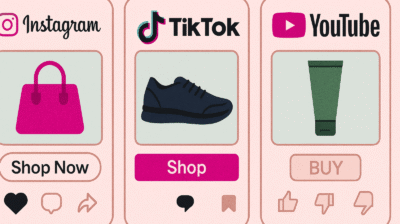
Collage of Shopping Interfaces from Instagram, TikTok and YouTube
Each social platform has added shopping capabilities that make creator commerce seamless:
Instagram and Facebook Shops
Creators can tag products directly in reels and posts. Audiences can view details and buy without leaving the app. Meta’s algorithm favors interactive shopping content, creating a self-reinforcing loop of engagement → sales → visibility.
TikTok Shop
TikTok’s “For You” feed is an ideal discovery engine. Viral products spread faster here than on any marketplace. TikTok Shop integrates checkout and fulfillment, letting influencers become full-time retailers.
YouTube Merch and Affiliate Integration
YouTube’s long-form storytelling builds deeper trust. Its new affiliate and “Merch Shelf” features let creators monetize reviews and tutorials directly.
Pinterest, Snapchat & Others
Visual discovery meets personalization. Pinterest’s “Idea Pins” and Snapchat’s “Spotlight” now include product links that reward both engagement and conversion.
From Influencers to Entrepreneurs
The biggest transformation in this revolution is identity. Creators are no longer just promoters; they are business owners building direct-to-consumer brands.
-
Beauty vlogger Huda Kattan founded Huda Beauty, a billion-dollar enterprise.
-
MrBeast’s snack brand Feastables became a mainstream retail product in months.
-
Fitness creators sell their own apps and digital coaching programs.
These examples prove that audiences are ready to follow creators beyond content—into commerce. It’s not celebrity endorsement; it’s community entrepreneurship.
The Creator Economy Infrastructure
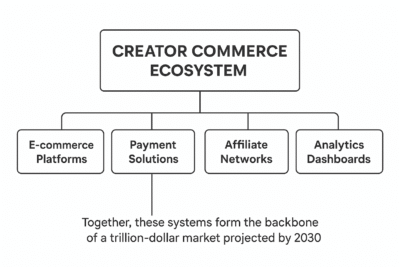
Creator Commerce Ecosystem Diagram Showing Tools and Revenue Streams
Behind the glamour lies an ecosystem of tools enabling this new economy:
-
E-commerce Platforms: Shopify, Kajabi, and Podia allow creators to build stores without coding.
-
Payment Solutions: Stripe and Razorpay streamline international transactions.
-
Affiliate Networks: Impact, ShareASale, and Amazon Associates connect creators with brands.
-
Analytics Dashboards: Social Blade, TubeBuddy, and native insights help track ROI.
-
AI Assistants: Chatbots and personalized recommendation engines boost conversion.
Together, these systems form the backbone of a trillion-dollar market projected by 2030.
The Psychology Behind Creator Commerce
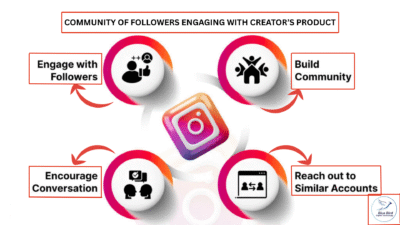
Community of Followers Engaging with Creator’s Product Launch post
Creator commerce thrives on emotion. People don’t just buy products—they buy identities. When a creator uses or designs a product, it becomes symbolic of a lifestyle.
Social Proof and Parasocial Relationships
Fans feel connected to creators as if they know them personally. This pseudo-friendship translates into trust—an incredibly persuasive marketing force.
Authenticity as Currency
Modern consumers detect inauthenticity instantly. Creators who disclose sponsorships and share honest opinions maintain credibility. In the long term, transparency sells more than hype.
Community Belonging
Buying through a creator often means joining their tribe. Fans display products as social signals—proof of shared values.
Data-Driven Social Selling
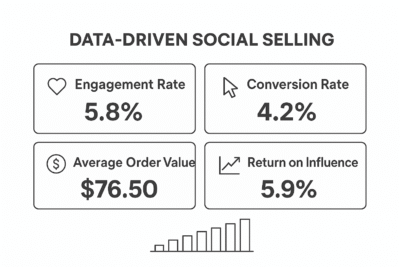
Dashboard Showing Creator Commerce Performance Metrics
Behind every viral post lies careful data. Creators analyze engagement, demographics, and watch-time to refine their sales approach. Platforms reward content that keeps users interacting longer, so creators use analytics to tailor timing, tone, and format.
Key Metrics for Creator Commerce:
-
Engagement Rate (likes + comments ÷ followers)
-
Conversion Rate (clicks ÷ views)
-
Average Order Value (AOV)
-
Return on Influence (ROI specific to creator collaboration)
AI tools like ChatGPT integrations, predictive analytics, and heat-map insights are becoming standard for top-tier creators seeking precision marketing.
How AI and Algorithms Shape Creator Commerce
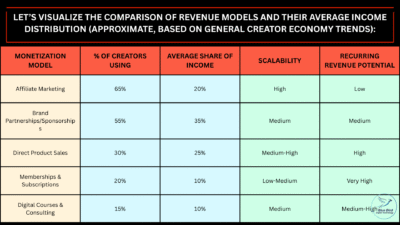
Comparison of Creator Revenue Models and Average Income Distribution
Artificial intelligence personalizes shopping journeys. Algorithms decide which products appear on a user’s feed based on past behavior, location, and micro-interactions. Creators who understand these systems can optimize content for maximum reach.
-
AI Recommendation Engines show users items similar to what they’ve liked in creator videos.
-
Automated Chatbots handle queries in real time, increasing conversion.
-
Predictive Analytics forecast trending categories for creators to enter early.
This merging of human creativity and machine intelligence defines the next frontier of digital marketing.
Monetization Models for Modern Creators
Money in the creator commerce revolution no longer depends on one revenue stream. Diversification is survival. Successful creators use a layered approach that combines several complementary models.
Affiliate Marketing
Creators earn a percentage every time a follower purchases through their unique link. The method scales easily because it requires zero inventory management. Smart creators embed affiliate recommendations naturally into tutorials or reviews rather than obvious promotions.
Brand Partnerships and Sponsored Content
Long-term partnerships now outperform one-off ads. Brands prefer year-long collaborations that align values and storytelling. The best contracts go beyond simple shout-outs—they involve co-developed products or creative direction input from the influencer.
Direct Product Sales
Owning a product line gives creators higher margins and full creative control. Whether it’s digital templates, skincare, or clothing, selling directly transforms creators into full entrepreneurs. Tools like Shopify Collabs and TikTok Shop simplify logistics.
Memberships and Subscriptions
Patreon, YouTube Memberships, and Discord communities allow recurring income. Fans subscribe for exclusivity: early access, behind-the-scenes content, or direct mentorship. Subscriptions create predictable monthly revenue and stronger community bonds.
Digital Courses and Consulting
Knowledge is currency. Experienced creators monetize expertise through masterclasses, coaching, or consultancy services. This approach is especially popular in marketing, finance, and design niches.
Building a Sustainable Creator Brand
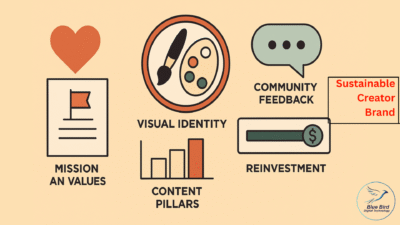
Creator Working on Brand Strategy Moodboard
Sustainability in creator commerce isn’t about the environment alone—it’s about long-term relevance. Creators who last a decade do so by treating themselves like evolving brands, not viral trends.
-
Mission and Values: Define what you stand for early. A mission attracts loyal audiences beyond trends.
-
Visual Identity: Consistent color palettes, fonts, and tone increase brand recall.
-
Content Pillars: Choose three to five core themes that reinforce authority.
-
Community Feedback: Encourage user-generated content and listen actively.
-
Reinvestment: Allocate income toward better production, research, and new platforms.
Challenges in the Creator Commerce Ecosystem
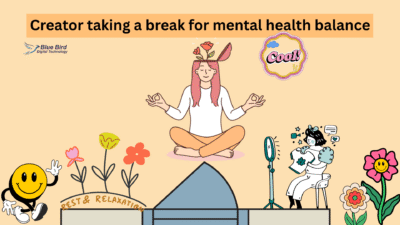
Creator Working on Brand Strategy Moodboard
Even revolutions face roadblocks. Creator commerce introduces its own unique set of challenges that determine who scales and who disappears.
Algorithm Dependence
A single platform change can slash reach overnight. Smart creators diversify platforms and build mailing lists to maintain audience ownership.
Authenticity vs. Monetization
Too many sponsored posts erode trust. Balancing profit with honesty is critical—audiences reward transparency and punish deception.
Legal and Tax Complications
Creators operate as micro-businesses. Understanding contracts, intellectual property, and cross-border taxation prevents costly mistakes. Agencies increasingly offer compliance support.
Mental Health and Burnout
Constant visibility can exhaust even top performers. Structured schedules, delegation, and mindful breaks protect creativity and consistency.
Case Studies: Real-World Success Stories
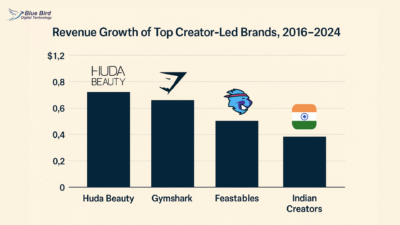
Revenue Growth of Top Creator-Led Brands 2016-2024
Huda Kattan – Huda Beauty
From blogger to billion-dollar mogul, Huda used authentic tutorials to build trust, then launched a cosmetic empire with direct fan support.
Gymshark
Started by fitness influencers promoting their own gear, Gymshark’s growth came entirely from creator partnerships and social storytelling.
MrBeast – Feastables & Beast Burger
His content empire funneled an audience of millions into tangible products. Transparency about profits and reinvestment nurtured fan loyalty.
Indian Creator Ecosystem
Creators like Ranveer Allahbadia and Komal Pandey illustrate how emerging markets use localized storytelling to blend culture with commerce.
The Role of Data Transparency and Ethical Marketing
Consumers increasingly care about how creators disclose partnerships and handle data. Regulations such as the EU’s Digital Services Act and the FTC Guidelines require explicit labeling of sponsored content.
Ethical creator commerce focuses on:
-
Honest Reviews: Admit product limitations.
-
Clear Disclosures: Use #ad or paid partnership tags transparently.
-
Data Privacy: Avoid collecting unnecessary user information.
-
Inclusivity & Representation: Feature diverse audiences and creators.
Following these principles not only ensures compliance but also strengthens brand integrity.
Technology Driving the Next Stage of Creator Commerce
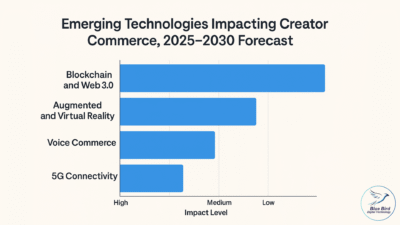
Emerging Technologies Impacting Creator Commerce 2025-2030 Forecast
Innovation doesn’t stop at AI algorithms; entire tech stacks are evolving to empower independent creators.
Blockchain and Web 3.0
Decentralized ownership lets creators tokenize products or issue NFTs for loyal fans. Smart contracts automate royalties across platforms.
Augmented and Virtual Reality
Virtual try-ons, AR filters, and metaverse pop-up shops blur entertainment and shopping. Brands like Gucci and Nike already experiment in this space.
Voice Commerce
Smart speakers turn creator recommendations into instant purchases through voice commands.
5 G Connectivity
Faster uploads mean higher-quality live shopping streams, giving audiences real-time interaction without lag.
The Future: Creator Commerce in the Next Decade
Industry forecasts suggest that by 2035, over 50 % of online purchases may originate through creator-driven channels. Three major shifts will define that future:
-
Hybrid Brands: Traditional companies will merge internal marketing with creator-led storytelling.
-
Localized Creator Networks: Regional micro-influencers will dominate because they connect authentically with language and culture.
-
Sustainability and Purpose: Social and environmental consciousness will influence collaborations.
The next decade will blur the boundary between a “brand” and a “personality.” In this new world, trust = currency, and creators = marketplaces.
Strategies for Brands and Creators to Succeed in Creator Commerce
Success in this revolution requires more than talent or a large following. Both creators and brands must implement strategic approaches that align trust, engagement, and commerce.
Building Trust Through Authentic Engagement

Creator Interacting with Audience in Live Session to Build Trust
Authenticity remains the single most important factor. Strategies include:
-
Responding to comments and DMs consistently.
-
Sharing both wins and failures.
-
Transparent disclosure of sponsorships.
-
Encouraging UGC (User-Generated Content) to increase credibility.
Data-Driven Content and Sales
High-performing creators use data not only to track sales but to refine content strategy. This includes:
-
Monitoring engagement metrics (likes, shares, click-throughs).
-
Analyzing watch time and drop-off rates to optimize video length.
-
Segmenting audiences for personalized campaigns.
-
Predicting trending products through AI and social listening.
Collaborative Partnerships
Long-term collaborations between brands and creators are more effective than one-off promotions. Best practices include:
-
Co-developing products with shared creative input.
-
Revenue-sharing agreements for mutual benefit.
-
Partnering with creators whose values align with the brand.
-
Creating cross-platform campaigns to maximize reach.
Multi-Platform Presence
Creators should not rely on a single social media channel:
-
Instagram and TikTok for discovery and short-form sales content.
-
YouTube for long-form tutorials and reviews.
-
Pinterest for visual discovery and evergreen content.
-
Email newsletters to maintain ownership of the audience.
Diversification protects against algorithmic risk and increases audience reach.
Content Marketing Tips for Maximum Impact
High-quality content drives both engagement and sales. Key tips for creators include:
-
Storytelling Over Promotion: Share personal experiences that naturally feature products.
-
Visual Consistency: Use branded colors, fonts, and layouts across platforms.
-
Interactive Formats: Polls, quizzes, and live streams increase engagement and trust.
-
Educational Content: Tutorials and tips add value while subtly promoting products.
-
Regular Posting Schedule: Consistency signals reliability to both audiences and platform algorithms.
Leveraging Emerging Technologies
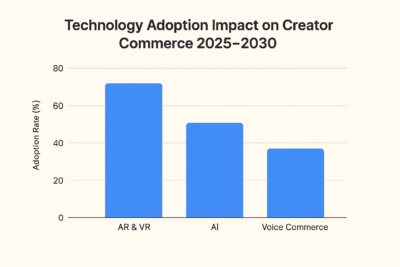
Technology Adoption Impact on Creator Commerce 2025-2030
AR & VR Shopping Experiences
Augmented and virtual reality allow fans to “try before they buy.” Examples include:
-
AR filters for makeup or fashion.
-
VR showrooms replicating a physical store experience.
AI-Driven Recommendations
Predictive algorithms suggest products to the right audience at the right time, increasing conversion.
Voice Commerce
Voice assistants like Alexa or Google Home are integrating with social platforms, enabling creators to monetize audio-first recommendations.
Legal, Ethical, and Compliance Considerations
Creators must navigate legal complexities to protect themselves and maintain audience trust:
-
Disclosure Laws: Clearly label sponsored content (#ad, #sponsored).
-
Intellectual Property: Ensure no copyright violations in content.
-
Consumer Protection: Do not make false claims or misrepresent products.
-
Data Privacy: Comply with GDPR, CCPA, and platform-specific guidelines.
Ethical compliance strengthens credibility and avoids costly penalties.
The Global Impact of Creator Commerce
Creator commerce is not limited to developed markets. Emerging economies are rapidly adopting these trends:
-
India: Regional creators like Ranveer Allahbadia engage local audiences with cultural relevance.
-
Southeast Asia: TikTok Shop is becoming the primary eCommerce driver.
-
Latin America & Africa: Mobile-first markets leverage micro-influencers for direct sales.
Global adoption signals that creator commerce is not a niche trend but a worldwide movement reshaping retail.
Best Practices for Scaling Creator Commerce

Creator Team Collaborating on Multi-Channel Strategy
Scaling requires strategic planning:
-
Automation Tools: Use social media schedulers, email automation, and CRM platforms.
-
Team Expansion: Hire editors, community managers, and marketing experts.
-
Inventory Management: For physical products, implement real-time stock tracking.
-
Cross-Promotion: Collaborate with other creators to expand reach.
-
Continuous Learning: Stay updated on platform changes, AI tools, and eCommerce innovations.
Scaling efficiently ensures long-term profitability and brand sustainability.
The Future of Creator Commerce: Predictions for 2030+
The next decade will cement creator commerce as a dominant retail force. Anticipated trends include:
-
Creator-Led Marketplaces: Entire shopping ecosystems run by creators.
-
Tokenized Products & NFTs: Fans owning digital assets or limited edition products.
-
Metaverse Shopping: Fully immersive virtual commerce experiences.
-
Micro-Creator Networks: Hyper-local influencers driving niche communities.
-
AI-Personalized Shopping: AI assistants recommending creator products in real-time.
These innovations will blur the line between content, community, and commerce, making creators both storytellers and primary brands.
Conclusion: The Era of Creator-Driven Commerce
The Creator Commerce Revolution is more than a trend; it is a paradigm shift in trust, engagement, and revenue. Creators have redefined what it means to build a brand—personal authenticity now equals market influence.
Key takeaways:
-
Trust Trumps Traditional Marketing: Audiences prefer recommendations from creators they admire.
-
Diversified Monetization Ensures Sustainability: Affiliate marketing, product lines, subscriptions, and consulting build multiple income streams.
-
Technology Amplifies Influence: AI, AR/VR, and predictive analytics maximize conversion.
-
Ethics and Transparency Matter: Compliance and honesty secure long-term success.
-
Global Opportunity: Markets worldwide are ready for this revolution, from India to Latin America to Southeast Asia.
For brands and creators alike, the message is clear: embrace authenticity, leverage technology, and design commerce experiences around community. Those who do will define the future of digital shopping and brand power for decades to come.


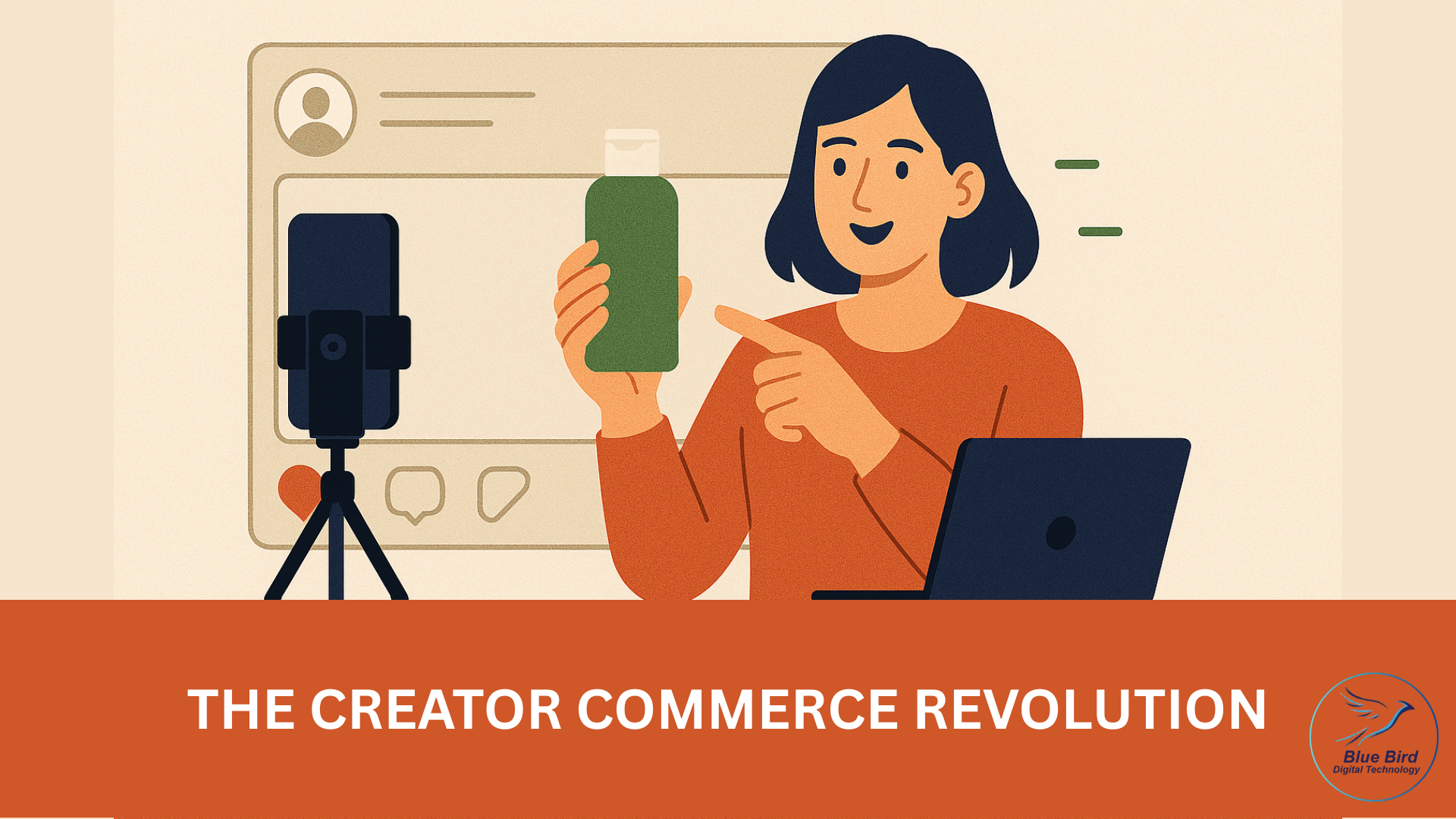
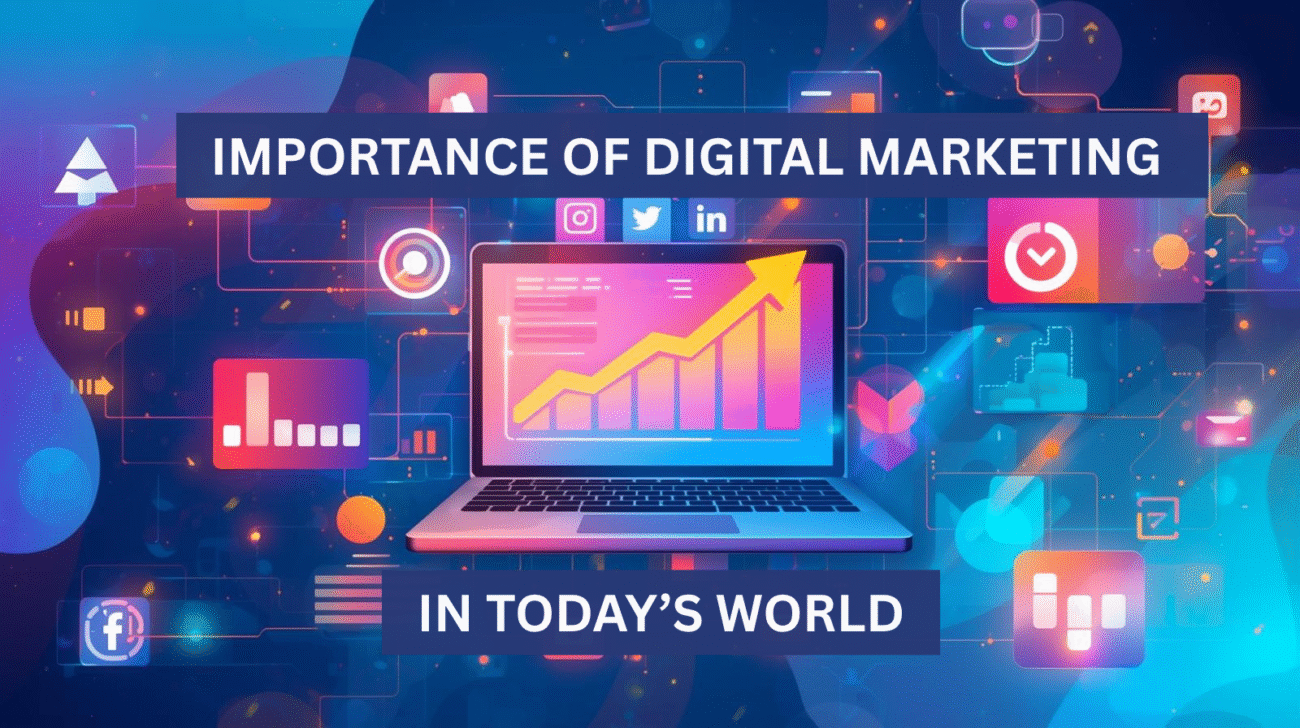
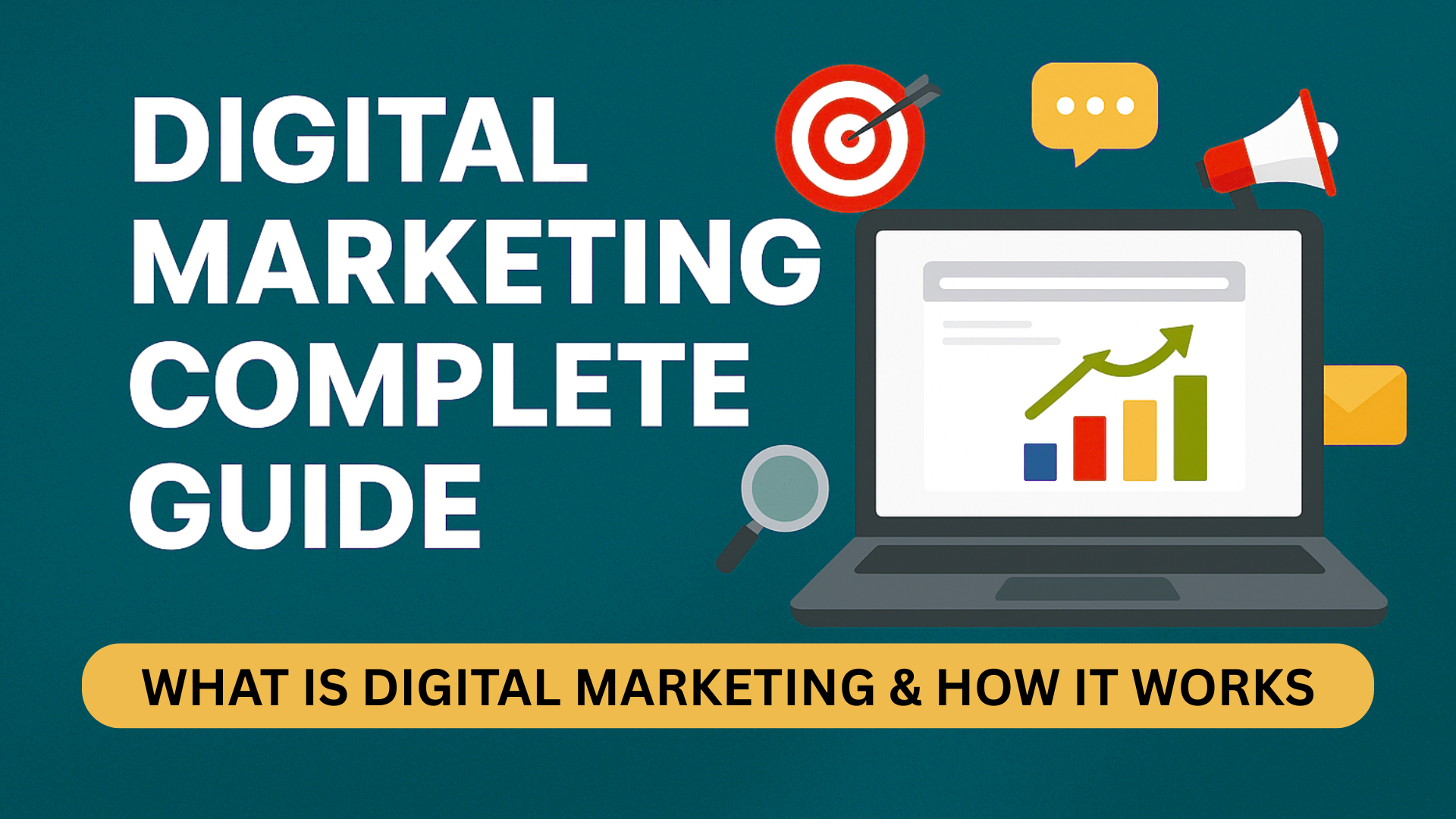
Such a timely and insightful read! The rise of creator-driven commerce is truly reshaping how we think about trust and brand loyalty online. I love how you highlighted the power creators have in driving not just sales, but authentic connections with their audience. It’s exciting to see where this revolution goes!
thank you so much
Really eye-opening! The way creators are now leading the charge in ecommerce is fascinating. You’ve captured how they’re influencing not just product recommendations, but a whole new level of brand transparency and customer engagement. It’s a game-changer for both creators and consumers.
thank you so much
Great article! The shift towards creator-led commerce really is a revolution. It’s amazing to see how trust and authenticity have become key drivers in the shopping experience today. As brands continue to collaborate with creators, I’m curious to see how this will evolve in the coming years!
thank you Porter